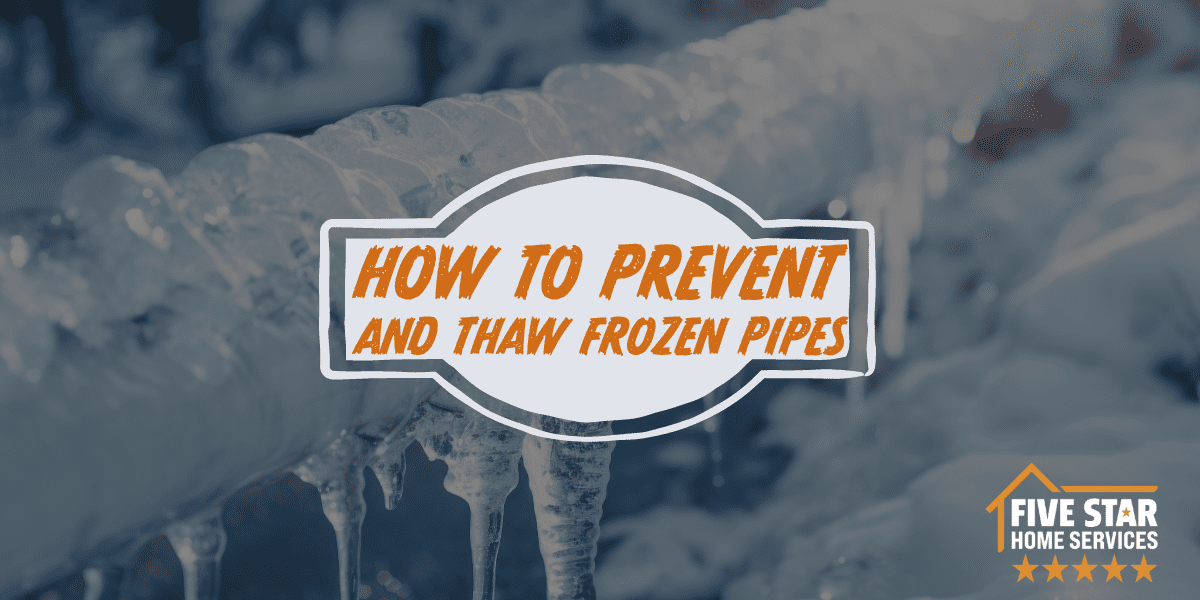Show your pipes some love this winter and prevent them from freezing
Frozen pipes are nothing a homeowner should take lightly. The national average cost to fix a burst pipe ranges from $400 to $1,500. If that’s not bad enough, pinhole leaks in pipes and plumbing can cost anywhere from $150 to $2,540 for repairs. Meanwhile, the basic service to merely unfreeze frozen pipes costs about $200.
At Five Star Home Services, we take pride in serving the Greater Dayton, Greater Cincinnati, and Greater Columbus areas with top-notch plumbing services throughout the year. We are here to help you protect your pipes! One of the more common problems we come across and address during the colder months is frozen pipe repair. In the following, we will share some valuable tips and information on how to prevent and thaw frozen pipes.
Preventing Frozen Pipes
Have you ever heard that old saying: “An ounce of prevention is worth a pound of cure?” This is especially true when it comes to protecting your pipes. One of the key steps a homeowner can take is to insulate their pipes — especially those pipes exposed to the elements during the wintertime. Insulation sleeves or heat tape can help to provide a layer of protection against frigid temperatures and reduce the risk of frozen pipes.
For pipes that are located along exterior walls or inside unheated areas such as basements or garages — we recommend you consider using a space heater. Remember, however, safety should come first when it comes to using space heaters. You can stay safe by keeping the heater away from flammable materials and turning it off when you’re not around. Also make sure it’s always placed firmly on a flat surface where it’s not at risk of being knocked over.
Last but not least, allowing your faucets to drip slightly when it gets especially cold outside also goes a long way. This continuous trickle keeps water moving in the pipes, making it much more difficult to freeze.
Thawing Frozen Pipes
If you’re already dealing with a frozen pipe — no worries! That’s what we are here for!!! You can call us anytime! Additionally, you’ll see we list some steps you can take to thaw it below:
- Open the faucet connected to the frozen pipe. This allows thawed water to escape.
- Apply heat to the frozen section of the pipe. This can be done using an electric heating pad, a hairdryer, or towels soaked in hot water. Remember, the goal is to thaw the pipe, not cook it, so keep the heat source moving to avoid damaging it.
- Continue applying heat until full water pressure is restored.
Still need help? Give us a call!
It’s essential to note that if you cannot locate the frozen area, if the frozen area is not accessible, or if you cannot thaw the pipe, you should call us at Five Star Home Services right away. We proudly serve Greater Dayton, Greater Cincinnati, and Greater Columbus, and our expert plumbing team is always available to help you with all your frozen pipe repair needs.
Resolving problems with frozen pipes quickly can prevent additional damage. Call Five Star Home Services for all your plumbing needs and have peace of mind knowing that your home is protected against winter. Call us today!
Six Ways to Prevent Frozen Pipes
These easy tricks for preventing frozen pipes can help ward off a home disaster when temperatures drop
Wintertime brings frigid cold temperatures here in Ohio, and when temperatures drop, the water that supplies your home’s fixtures and faucets becomes at risk of freezing inside your pipes. Because water expands when it turns into ice, frozen pipes are far more prone to bursting, which can result in expensive water and plumbing damage throughout your home or business.
These pipes are generally at the highest risk of freezing; they include pipes that run against exterior walls and pipes located in poorly-heated areas or areas that aren’t insulated well — such as basements, attics, or garages.
Before the temperatures outside fall below freezing, it is important to understand how to prevent them and take the necessary steps to winterize your home. In the following, we encourage you to read on to learn a few simple tricks we at Five Star Home Services are offering to help you protect your pipes from freezing and keep the water running throughout the coldest weather. We can also walk you through what to do if you believe your pipes might be frozen and how to thaw them to ward off much more serious home disasters.
1. Insulate your pipes.
Pipe insulation is cheap and widely available at home improvement stores. We recommend insulating any pipes located in unheated areas — including attics, basements, crawl spaces, and garages. In extremely cold conditions, pipes underneath kitchen and bathroom sinks are also vulnerable to freezing. Be sure to remember these. You can apply foam insulation to provide a buffer against frigid temperatures. Wrapping your pipes in heat tape or thermostat-controlled heat cables can also help to keep them warm enough to prevent freezing.
2. Seal air leaks.
Air leaks are another major problem. Inspect your home for cracks or openings that could allow the cold air to get inside. Be sure to seal any holes around the piping in interior or exterior walls and the sill plates, where the foundation of your home rests. Additionally, because leaving your garage open creates a massive air leak — always remember to keep the door closed unless you’re going in or out.
3. Disconnect your garden hoses.
Once you finish tending to your garden for the season, remember to disconnect your hoses and drain them. Shut off any shut-off valves that supply outdoor hose bibs and open the faucet outside to drain the line. Remember to keep it open during the winter to allow space for any water that remains in the pipe to expand. You can also consider using faucet covers throughout the colder months for extra protection against frozen pipes. They only cost a few dollars at your local hardware store. Additionally, you can drain water from any sprinkler supply lines following the manufacturer’s directions.
4. Allow your faucets to drip.
When it comes to preventing pipe freeze — a small trickle of water goes a long way. In fact, keeping a steady drip can prevent ice from forming inside your pipes because it keeps the water moving. When it gets below freezing cold outside, start a drip of water from all your faucets served by exposed pipes. Leaving a few faucets running slightly will also relieve pressure inside the pipes and help prevent a rupture if the water inside freezes.
5. Maintain a consistent temperature.
Adjust your thermostat to maintain a consistent temperature throughout the day and night. In normal weather, you can bump your thermostat down at night or when you’re away from home. This can help save on heating costs. However, during times of extreme cold, maintaining a steady temperature is essential for keeping your pipes free of ice. Additionally, if you are away from home during cold weather, make sure your thermostat is set to at least 55°F. These few extra dollars you’ll spend on your utility bill is well worth it. You’ll save thousands by avoiding busted pipes.
6. Open cabinets and doors.
Make sure warm air can circulate evenly throughout your home during cold spells. We recommend leaving interior doors ajar and opening your kitchen and bathroom cabinets to distribute heat consistently around rooms. However, make sure to remove any household chemicals or potentially harmful cleaners from open cabinets if you have small children or pets in your home.
What to Do if Your Pipes Freeze
If you believe you have a frozen pipe, you can check by turning the faucet on. If you only get a drip or trickle of water flowing out — you probably have an ice blockage. If this is the case, you should carefully inspect the exposed pipe for any breaks or cracks. If any of your pipes have burst, you should turn off the main water supply for the house and give us a call right away. Our plumbers at Five Star Home Services are always available for assistance. Attempting to thaw a pipe on your own that has already burst can cause water to flow out and flood your home. This can cause additional damage.
If your pipe is still intact, turn the faucet on to allow water to flow through it while the ice melts. Then, gently apply heat to the frozen sections of the pipe — using a heating pad, space heater, hairdryer, or warm, damp towels. While these usually suffice, you should never use an open flame to heat a frozen pipe. This is a fire hazard and can damage the pipe. If you are unable to access or safely thaw the frozen pipe, call a licensed plumber right away at (833) 405-8009 or schedule services online now!

